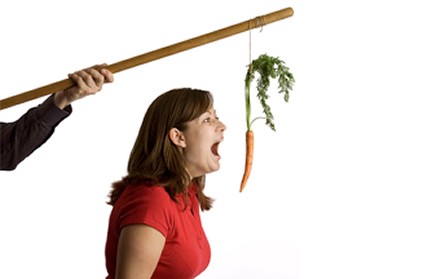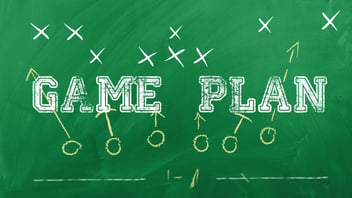The Five Traits of Great Customer Incentives
Kid won't eat dinner or do their homework? You can try withholding dessert and video games, but that only builds resentment from the little darlings.
Many parents, myself included, find that incentivizing behavior is the ticket to success.
Go a week without picking on your sister? Here's a trip to the arcade.
Perfect grades for the semester? New video game.
We're not talking about throwing a cookie into the mouth of a screaming child after a parent rejects buying a $200 LEGO castle. That's bribery, not incentivizing, and it's not a good way to build long-term habits.
The idea is to express that doing something of value can have even more, extra value attached to it. It's rewarding the right behavior to help them see the value of that behavior. It works for many parents, and it works for many businesses.

A Little Somethin' Extra
It's a highly competitive world out there. Consumers are seeing more branding than ever before. They're more scrutinous of brands. During the holidays, they throw loyalty out the window in favor of deals.
It's a tough environment to try to capture attention in, yet when consumers connect with a brand that fits their needs, they'll stick around. The key is simply getting their attention.
This is where customer incentives come into play. The right "something extra" can make all the difference to a customer who's on the fence, or one who hasn't shown his/her face around the brand for a while.
But what is the right customer incentive? Here are five traits of incentives that will put a brand in position to connect with a customer in a way that could result in a long-term, profitable relationship:
1. It extends the relationship
A single use incentive, such as a flight voucher, can be exciting to customers, but they really don't extend the customer/brand relationship beyond that point. The most effective incentives are multi-use, giving consumers repeated exposure to the brand months beyond a purchase.
Bonus: Incentives used to encourage signups for loyalty programs definitely fall under this category, even if the incentive itself isn't multi-use. If you have a loyalty program that is engaging and relevant, the incentive is worth the cost.
2. It's scalable
Yeah, handing out iPads to every new customer is an effective acquisition strategy for say, a plumber, but it's going to break his profitability. Higher-end incentives such as iPads are perfect for someone selling luxury automobiles or new homes, however.
On another note though, those iPads might work well for loyalty if the plumber wants to "surprise and delight" a few of his longtime customers. (See this post last year for a great S&D example.)
You're going to pay a price of some sort for an incentive, but it has to be scalable and match the scope of the action you want them to take, and the potential profitability you gain from that action.
The incentive has to match the sale or end goal. Obvious, but it doesn't mean anyone has to settle on cheap squishy balls or branded pens to try to bring a customer in. Giving away iPads is cool, but giving away something that hits home with your target audience at an affordable price is even better.
3. It promotes the right brand
A business gave me a gift card to Outback Steakhouse about two years ago. I remember going to the restaurant; I have NO idea who it was that gave it to me. Even if the incentive is a gift card to a different company or a discount program involving dozens of other brands, YOUR brand and messaging need to be front and center. Otherwise, what's the purpose?
4. It has meaning to the customer
This goes back to #2, but the best incentives do more than just provide any trinket cluttering up your kids' toy box. Know your target audience. Are they into saving money? Try discounts. Are they social creatures? Reward them for sharing with friends. Your incentive should either help them solve a problem or enable a behavior that you want your brand to be involved with (such as social sharing).
5. It's measurable
This is the tricky part of incentives. What's the ROI? Everyone wants to have a clear ROI on every dollar spent, but the return on incentives may not always be sales. They are meant to be a "gift" or "reward," after all.
Look for incentives that offer some sort of insight into their performance. It could be signups, redemptions, or even direct customer feedback. The key is having realistic goals for the incentive, knowing how those metrics affect those goals, and having an organization that effectively manages the customers brought in or engaged by the incentives. There's probably not a magic bullet success metric, but by measuring what's available you can get a good idea of success.
Eat Your Vegetables, Take Your Vitamins, Offer Incentives
In an ideal world a good product or service at a fair price would be enough to guarantee success with customers. That's obviously not the case for most brands - it takes extra effort to grab people's attention and get them moving in the right direction, even if they've been a customer for years. Incentives can play a big role in bringing people to a brand and keeping them there, then spurring them to action from time to time.
But, as any parent will tell you, it has to be the right incentive aimed at the right goal, otherwise you're just bribing them, which offers only short-term benefits. By focusing on customer incentives or gifts that reward profitable behaviors, brands can trigger a mutually beneficial relationship - an important step in the ongoing quest for customer loyalty.
(Ice Cream photo courtesy of Justin Wise)
Topics: Customer Engagement, incentive programs
Written by: Brandon Carter





.jpeg)







Share your Comment.